Sustainable Development Topics
Freshwater/Water
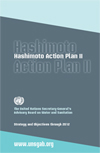 |
TITLE | Hashimoto Action Plan II [pdf 129 Kb] |
| DATE | January 2010 | |
| ANNOUNCEMENT |
The United Nations Secretary-General's Advisory Board on Water and Sanitation (UNSGAB) is embarking on their next strategic phase with the release of the Hashimoto Action Plan II. In only a few years, world leaders will assess progress made towards the Millennium Development Goals, including the targets to halve by 2015 the number of people without sustainable access to safe drinking water and basic sanitation. Getting the right policies, strategies and actions in place during the next three years is absolutely critical. The Hashimoto Action Plan II contributes to this effort by motivating, convening and galvanizing its partners to achieve objectives in five key areas: financing, sanitation, monitoring & reporting, integrated water resources management and water and disaster. The Hashimoto Action Plan II articulates a time-bound vision, targeted actions and clear outcomes aiming to ensure a future where each child, woman and man enjoys clean water and safe sanitation. The UNSGAB secretariat welcomes feedback, ideas and comments. |
|
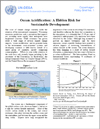 |
UNDESA DSD COP15 Policy Brief #1 |
Ocean Acidification: A Hidden Risk for Sustainable Development December 2009 [pdf 70 KB] |
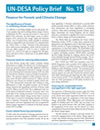 |
Policy Brief #26 | UNDESA Policy Brief # 26: Ocean Acidification: A Hidden Risk for Sustainable Development December 2009 [pdf 745 KB] |
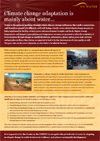 |
TITLE | UN-Water Key Messages on Climate Change and Water English [pdf 314 Kb] Español [pdf 320 Kb] |
| DATE | November 2009 | |
| FORWORD |
UN-Water Presents Key Messages on Water & Climate Change for COP 15 Water is the primary medium through which climate change influences the Earth's ecosystems and therefore people’s livelihoods and well-being. Climate change adaptation, therefore, is mainly about water. On November 3 UN-Water presents its key messages on water & climate change as a contribution to COP 15 in Copenhagen this December. | |
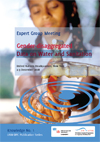 |
TITLE | Gender-Disaggregated Data on Water and Sanitation [pdf 2 MB] |
| DATE | June 2009 | |
| CONTENTS excerpt: |
Expert Group Meeting Report: Gender-Disaggregated Data on Water and Sanitation Forewords..............................................................................4 Rationale and Goals................................................................8 Participation and Presentations.................................................11 Summary of Overarching Themes..............................................13 Obstacles to developing, collecting and using gender-disaggregated data on water and sanitation...............17 Data collection needs: gender-disaggregated indicators currently unrepresented or under-represented....................................23 Summary Indicator Table..........................................................26 Recommendations, including six gendered indicators...................28 Annex: List of participants........................................................31 |
|
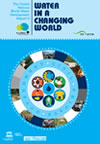 |
TITLE | 3rd United Nations World Water Development Report: Water in a Changing World [HTML] |
| DATE | March 2009 | |
| FORWORD excerpt: |
With the release of this third edition of The United Nations World Water Development Report, it is clear that urgent action is needed if we are to avoid a global water crisis. Despite the vital importance of water to all aspects of human life, the sector has been plagued by a chronic lack of political support, poor governance and underinvestment. As a result, hundreds of millions of people around the world remain trapped in poverty and ill health and exposed to the risks of water-related disasters, environmental degradation and even political instability and conflict. Population growth, increasing consumption and climate change are among the factors that threaten to exacerbate these problems, with grave implications for human security and development............ | |
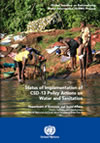 |
TITLE | Status of Implementation of CSD-13 Policy Actions on Water & Sanitation [pdf 4.5 MB] A Country Level Survey |
| DATE | December 2008 | |
| PREFACE excerpt: |
...This report is an attempt to further the implementation agenda in the domain of water
and sanitation. It is based on a survey carried out in 35 countries under the project
“Global Initiative for Rationalizing Water-Related Information (GIRWI )”, on the state
of implementation of policy actions and measures relating to integrated water resources
management, water supply and sanitation. The survey collects information on three questions: what works (and what doesn’t), what areas need urgent attention, and how to scale up successful practices. It builds upon the decisions reached during the 13th Session of the Commission on Sustainable Development (CSD) in 2005, under which integrated resource management was accepted as a common framework for the sustainable development of water and sanitation sectors. The countries selected for the survey represent a wide spectrum of human, natural, and economic resources... |
|
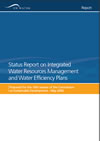 |
TITLE | Status Report on Integrated Water Resources Management and Water Efficiency Plans at CSD 16 [pdf 1.73MB] |
| DATE | May 2008 | |
| SYNOPSIS | The Report, compiled by UN-Water, aims to illustrate progress made on meeting the target to “Develop integrated water resources management and water efficiency plans by 2005, with support to developing countries, through actions at all levels” agreed at the World Summit on Sustainable Development (WSSD) in Johannesburg in 2002, through the Johannesburg Plan of Implementation (JPoI). The Report is based on a survey covering 104 countries. The survey brings together the results of questionnaires by UN-DESA DSD and UNEP carried out in 2007 | |
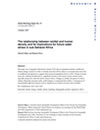 |
TITLE | The relationship between rainfall and human density and its implications for future water stress in sub-Saharan Africa, DESA Working Paper No. 57 [pdf 1.51 MB] |
| DATE | October 2007 | |
| ABSTRACT | This paper uses Geographic Information System (GIS) data on population density, rainfall and climate change scenarios in order to identify areas that will be subject to increased water stress due to insufficient precipitation to support their projected population levels in 2050. Density increases across the continent should lead to a significant increase in the extent of water stressed zones, especially around the Sahel belt and in Eastern Africa. Changes in rainfall, the pattern of which remains inherently uncertain today, could mitigate or compound those effects. Consequences of unsustainably high local densities such as migrations are bound to become more prevalent. | |
 |
TITLE | Sustainable Development Innovation Briefs :: Issue 4 Providing water to the urban poor in developing countries: the role of tariffs and subsidies |
| DATE | October 2007 | |
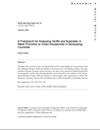 |
TITLE | A Framework for Analyzing Tariffs & Subsidies in Water Provision to Urban Households in Developing Countries [pdf 462 KB] |
| DATE | February 2007 | |
| ABSTRACT excerpt: |
This paper aims to present a basic conceptual framework for understanding the main practical issues
and challenges relating to tariffs and subsidies in the water sector in developing countries. The paper
introduces the basic economic notions relevant to the water sector - presents an analytical framework for assessing the need for and evaluating subsidies - and discusses the recent evidence on the features and performance of water tariffs and subsidies in various regions, with a special focus on Africa. The discussion is limited to the provision of drinking water to urban households in developing countries. |
|
 |
TITLE | Integrated Plan for Chad's Water Development & Management 2003 - 2020 [HTML] |
| LANGUAGES | English | Français | |
 |
TITLE | Meeting the MDG Drinking Water & Sanitation Target: A Mid-Term Assessment of Progress [HTML] (UNICEF/WHO) |
| FOREWORD excerpt: |
The combination of safe drinking water and hygienic sanitation facilities is a precondition for health and for
success in the fight against poverty, hunger, child deaths and gender inequality. It is also central to the human
rights and personal dignity of every woman, man and child on earth. Yet 2.6 billion people – half the developing
world – lack even a simple ‘improved’ latrine. One person in six – more than 1 billion of our fellow human
beings – has little choice but to use potentially harmful sources of water... In adopting the Millennium Development Goals, the countries of the world pledged to reduce by half the proportion of people without access to safe drinking water and basic sanitation... Programme on Water Supply and Sanitation (JMP), provides the latest estimates and trends on where we stand today... |
|
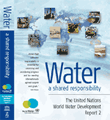 |
TITLE | 2nd United Nations World Water Development Report: 'Water, a shared responsibility' [HTML] |
| DATE | 2006 | |
| SYNOPSIS | The report presents a comprehensive picture of freshwater resources in all regions and most countries of the world as it tracks progress towards the water-related targets of the UN Millennium Development Goals and examines a range of key issues including population growth and increasing urbanization, changing ecosystems, food production, health, industry and energy, as well as risk management, valuing and paying for water and increasing knowledge and capacity. Sixteen case studies look at typical water resource challenges and provide valuable insights into different facets of the water crisis and management responses. | |
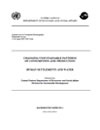 |
TITLE | Changing Unsustainable Patterns of Consumption & Production: Human Settlements & Water CSD-13 Background Paper No. 4 [pdf 367 kb] |
| DATE | April 2005 | |
| CONTENTS | I. INTRODUCTION............................................................................3 II. HUMAN SETTLEMENTS...................................................................4 1. Urban planning............................................................4 2. Urban transportation....................................................5 3. Solid waste management and recycling..........................10 4. Sustainable construction, building management and household energy...........................................................16 III. URBAN AND INDUSTRIAL WATER CONSERVATION..........................20 1. Water conservation.....................................................20 2. Wastewater treatment and reuse..................................23 IV. CONCLUSION............................................................................24 Notes............................................................................................25 |
|
 |
TITLE | Booklet on the International Decade for Action: Water for Life Decade [2005–2015] [pdf 2,109 KB] |
| DATE | March 2005 | |
| CONTENTS | A message from the Secretary-General ...........................................3 Water and the Millennium Development Goals .................................4 Water for women .........................................................................6 Water for biodiversity and the environment .....................................8 Water for food, agriculture and rural livelihood ...............................10 Water for sanitation and health ....................................................12 Water for energy ........................................................................14 |
|
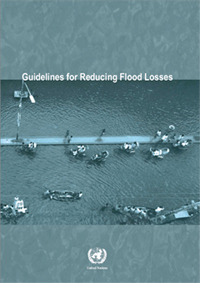 |
TITLE | Guidelines for Reducing Flood Losses |
| DATE | April 2004 | |
| FOREWORD excerpt: |
Throughout the history of mankind, floods have brought untold wealth and prosperity to
civilizations, and yet at the same time, they have caused tremendous losses and resulted in
untold suffering for millions of people. Even today, floods lead all natural disasters in the
number of people affected and in resultant economic losses, with these numbers rising at
alarming rates
In response to the devastation arising from water-related natural disaster, particularly flooding, a series of three workshops and symposia were held, sponsored by the United States National Oceanic and Atmospheric Administration (NOAA) and the United Nations Department of Economic and Social Affairs. One objective of these events was to create comprehensive guidelines that could be used by governments, international organizations, non-governmental organizations and civil society to help avert losses from flooding.... ...This publication is based on the findings of those three sessions and is a contribution to the overall efforts that are required to help society cope with the forces of nature... |
|
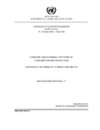 |
TITLE | Changing Unsustainable Patterns of Consumption & Production: Experiences in Human Settlements & Water CSD-12 Background Paper No. 11 [pdf 80 kb] |
| DATE | April 2004 | |
| INTRO excerpt: |
The Johannesburg Summit noted that fundamental changes in the way societies produce and consume are indispensable for achieving global sustainable development. It agreed that all countries should promote sustainable consumption and production patterns, with the developed countries taking the lead and with all countries benefiting from the process. For this purpose, the Johannesburg Plan of Implementation (JPOI) called for the development of a 10-year framework of programmes in support of national and regional initiatives to accelerate the shift towards sustainable consumption and production to promote social and economic development | |
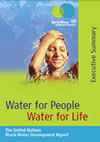 |
TITLE | Water for People Water for Life The United Nations World Water Development Report Executive Summary [pdf 962 kb] |
| DATE | 2003 | |
| CONTENTS excerpt: |
Setting the Scene.............................................................................4 A Look at the World’s Freshwater Resources.........................................8 Challenges to Life and Well-Being.....................................................11 Management Challenges:Stewardship and Governance........................23 Pilot Case Studies...........................................................................32 |
|
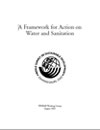 |
TITLE | A Framework for Action on Water & Sanitation [pdf 224 kb] (WEHAB Working Group) |
| DATE | August 2002 | |
| CONTENTS | Preface and Acknowledgments..........................................................5 Water and Sanitation: Key Issues and Challenges...............................7 Addressing the Challenges in Water and Sanitation............................13 Water and Sanitation: Frameworks for Action.....................................17 Annexes Major Agreements on Water and Sanitation and Their Objectives..........25 UN System Capacities in Water and Sanitation...................................34 |
|

